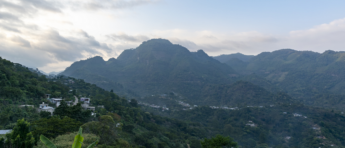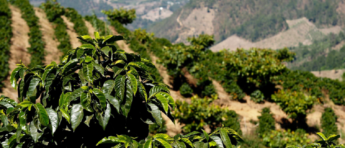Our Approach to Sourcing Green Coffee
- Sourcing
- May 23, 2025
Servant Coffee was founded with the fundamental belief that everyone prospers when we serve each other well. As we reflect on how far we’ve come as a roaster, as a team, and as individuals, we also take time to consider how well we continue to live in alignment with our values and core principles. A lot has changed since we started this journey, with some elements of our story growing and evolving like any business, but our core philosophy remains in clear and constant focus: to provide consistently high-quality coffee, maintain deep relationships at origin with repeat buying, and value every connection we make along the way.
One of the main ways we try to live this philosophy is through our approach to sourcing green coffee. Many claims are made about the social, environmental, and economic impacts of ‘specialty’ coffee, few of which are more prominent (or complicated) than how these amazing coffees are identified and procured. Before we dive into this complex topic, however, you may be asking: what exactly does ‘specialty coffee’ mean?
The term ‘specialty coffee’, first coined in 1974 by Erna Knutsen in an issue of Tea & Coffee Trade Journal, is used to differentiate certain coffees from ‘commodity’ coffee. Commodity coffee is typically identified as coffee that is traded on the global market as a uniform product (commodity) and is interchangeable with other coffee of the same type. The price of commodity coffee is set on the world market without regard to the coffee’s quality, and it’s often mass-produced, blended, and roasted for a more generic and uniform taste. Commodity coffee generally has little traceability, minimal focus on sustainability, and is primarily used in instant coffee and pre-ground coffee blends like Folgers that prioritize flavor consistency and low price.
The term ‘specialty coffee’ is used to describe coffees that place a strong emphasis on responsible and sustainable practices at every level of coffee production, preparation, and consumption. From a quality standpoint, these coffees score 80 points or above on the 100-point scale used on the Specialty Coffee Association’s (SCA) industry-standard cupping form. Coffee scoring from 90–100 is graded Outstanding, coffee that scores 85–89.99 is graded Excellent, while coffee scoring 80–84.99 is graded Very Good. Prices paid for coffees that qualify as ‘specialty’ are often many times higher than prices paid for commodity coffee and can fundamentally alter the economics of growing coffee for the farmers and producers of green coffee. Whereas the price of commodity coffee is governed by global market forces and can vary widely from year to year (or month to month), the prices typically paid for specialty coffee are fairly consistent for a given level of quality. Some lower grade specialty coffees, the ‘Very Good’ coffees mentioned above, can go for $2-4/lb, and that price won’t change significantly from harvest to harvest. The finest green coffees in the world can fetch nearly $1000/lb at auction! No, that’s not a typo. Consistent and representative pricing allows coffee producers to grow coffee knowing that their risk of exposure is relatively low and provides a strong incentive to keep growing and improving the quality of their coffee year over year. If a producer is beholden to the global commodity price, a situation could arise in which it’s no longer economically feasible to grow coffee and thus they may decide to focus on producing other agricultural products that provide more price stability.
So, how does all of this tie into sourcing green coffee? As with any raw material, how we actually get green coffee is critically important to how we do business. At Servant Coffee, we can generally break down our sourcing practices into the following categories: spot buying, contract buying from importers, pre-contract buying at origin, and dedicated trust buying from producers at origin.
Spot Buying
When green coffee is brought into the US from abroad, it’s commonly done so by coffee importers. Coffee importers come in all shapes and sizes, from big names like Café Imports that bring in coffee from all over the world in vast quantities to smaller, more specialized operations that focus on small volumes and specific coffees or regions. Most of these importers purchase a set amount of coffee from specific producers, import it to the US, and store it in their warehouses as inventory. This is known as ‘spot’ coffee, and buying coffee this way represents the 1st tier of our coffee buying practice. Spot buying happens when we look through all the coffee available in an importer’s inventory and can order coffees as needed. We try to avoid spot buying unless we really don’t have any other options because it removes the personal connection from the coffee sourcing experience and can be significantly more expensive due to a variety of mark-ups along the way. Very little of our coffee is bought on spot, but this is a common way to source when a roaster is first getting started given the lower volume of coffee needed.
Contract Buying from Importers
The next tier of coffee sourcing is where we commit to purchase (contract) a certain amount of coffee at a specific price, usually at some time between when the coffee is being harvested to when it arrives at the warehouse in the US. As your coffee roasting business grows, you can start shifting from spot buying to contracting a set volume of coffee each year through an importer. Contracted coffee is the first step to developing a relationship with a producer since you’re putting more trust in a specific group at origin. These purchases still rely heavily on importers, but there is an added element of sustainability as we show a level of commitment to buying these coffees, allowing the importers to make more confident purchases from the producers. At Servant Coffee, very little of our coffee comes from contracts with importers in the US.
Pre-Contract Buying at Origin / ‘Impact’ Lots
This next tier of sourcing coffee is where we actually pre-contract a set amount of coffee for an upcoming harvest directly from the producer in the country of origin. This usually involves personal visits to the country to understand which farms they are sourcing coffee from and how they work with each one to continually improve their quality and process. Our ideal relationships are with producers who not only grow the coffee but also understand the coffee life cycle all the way through production, milling, and roasting. A producer that grows coffee but also understands the processing and roasting is buffered from the risks of growing – the uncertainty of bad weather, a bad harvest, and other normal risks incurred by producing an agricultural product of any kind. Knowledge of the full coffee lifecycle allows producers to incorporate more data in making adjustments to various parts of the process to improve their coffees. This is how our team at Servant Coffee sources most of our coffee, both for blends and for single origins. You may notice our ‘Impact Lot’ designation on particular single origin bags as well, which indicates that the coffee was purchased through this level of sourcing at minimum. For these coffees, we still need a trusted importer to get the coffee to the US, so we enter into an agreement to pay the importer a small fee to ensure the coffee is brought and warehoused in the US appropriately.
Dedicated Trust Buying from Producers at Origin
One further step on the journey of coffee sourcing is to have a relationship with a producer that is based on multiple years of working together and has reached a high level of trust. With these relationships, we don’t even need to cup/evaluate the pre-harvest samples because we know with a high degree of certainty how the coffee will taste based on the consistency of previous harvests. However, this involves finding the right partner who aligns with you on coffee philosophy and has all the tools necessary to ensure quality production year in and year out.
ADDITIONAL POINTS ON SOURCING:
Repeat Buying
As we’ve discussed, souring coffee is all about relationships. In order to maintain these relationships over time we make every attempt to buy coffee from the same producers year after year, which we consider a significant step in building trust and mutually beneficial relationships. A prime example of this is our work with Rosalba Cifuentes and Mayan Harvest in Chiapas, Mexico. We’ve had the pleasure of visiting Rosalba and her team in the beautiful but very remote Bella Vista region in southern Chiapas, and you can read about our visit in more detail here. Being able to count on us to buy coffees from Mayan Harvest every year allows the team to make a substantial impact on the surrounding community. Consistent, repeat business and fair prices allow these very small producers to re-invest more of their revenue into improving the quality of the coffee, which reduces the amount of money the producers would otherwise need to borrow to maintain and improve their farms, which cuts into bottom line profits for the farmers. Higher prices and profits also flow into the surrounding community, providing funds for improving local infrastructure, increasing access to education and healthcare, and creating other social and economic opportunities. In an area this remote, with the wide variety of challenges people face in everyday life, confidence in their green coffee revenue year to year can be extremely impactful. The majority of the coffee we purchase from Central America are, at minimum, 2nd time purchases, with a core few relationships dating back to our founding in 2019.
Origin Visits
We consider origin visits a vital element of our green coffee sourcing relationships. We make a concerted effort every year to visit at least one producer that we buy coffee from. These visits are most frequently to producers that already fall under our ‘repeat buying’ relationships, and these visits present some additional benefits for both our team and our producers above and beyond consistent coffee buying. These trips allow us to connect with the entire team that help get the coffee grown, picked, processed and ready for market. We have the opportunity to see the farms where our coffees are grown and speak directly with the farmers and other workers that grow and harvest the coffee. We have the opportunity to hear about new cultivars, different growing techniques, sustainability initiatives and even some cool and experimental processing techniques. These visits allow the producers to ask us questions and learn more about the concerns of the roasters and end users so they can continue to improve their processes and stay in alignment with market trends. From a more practical standpoint, these visits also allow us to sample a wide variety of coffees available from these producers each harvest before these coffees are made available to the wider green coffee market. Each time we visit we deepen our appreciation for the many hands and laborious hours that go into producing consistently high-quality green coffee. We always learn a tremendous amount from these visits, which you can read more about here, and it’s a very special experience for us to connect directly to the people and places at the heart of our most critical relationships.


